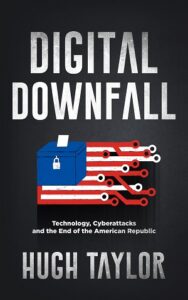My New Book, Digital Downfall, Reveals Foreign Cyber Role in Current American Unrest
 I am excited to announce the publication of my new book, Digital Downfall: Technology, Cyberattacks and the End of the American Republic. Many of the experts I have interviewed on this blog are featured in the book. I will highlight their contributions in upcoming articles.
I am excited to announce the publication of my new book, Digital Downfall: Technology, Cyberattacks and the End of the American Republic. Many of the experts I have interviewed on this blog are featured in the book. I will highlight their contributions in upcoming articles.
The book reveals how Russian and Chinese cyberattacks and digital influence campaigns have aggravated the already destabilizing effects of the COVID 19 pandemic and anti-police protests. It offers an analysis of the national security problems arising from our reliance on insecure technology to run virtually every aspect of our government and society—to the point where the survival of the US government itself is in jeopardy.
This may sound insane, but a sober look at the current situation will reveal an unfortunate truth: The US is more vulnerable to destructive foreign interference today than it has been in over a century. Russia and China realize they can’t win shooting wars against the US, so they’re using digital technology to inflame existing divisions in our society to weaken us and distract us from their own aggressive geopolitical agendas.
A sober look at the current situation will reveal an unfortunate truth: The US is more vulnerable to destructive foreign interference today than it has been in over a century.
In the book, I use data about cyberattacks and known weaknesses in US technology infrastructure to build risk scenarios. I posit that multi-faceted cyber and disinformation attacks could trigger unparalleled chaos and disruption in the US. What’s really crazy is that my scenarios are coming true sooner than I might have guessed. Events that seemed paranoid, even loony to predict when I was writing the book six months ago now seem painfully prescient.
Software bots accounted for nearly half the tweets that encouraged heavily armed men to threaten elected officials with death in protests over COVID-19 lockdowns. We don’t know who created these bots.
For instance, software bots accounted for nearly half the tweets that encouraged heavily armed men to threaten elected officials with death in protests over COVID-19 lockdowns. We don’t know who created these bots. They could be from Russia, China or the USA. However, the fact that we can’t figure this out reveals the depth of the problem, from a national security perspective. We are nearing a state of armed insurrection and we don’t know who gave the order to get the process rolling.
The book takes an unsparing look at the consequences of using inherently insecure computers and networks to power American industry, government, telecommunications, military and news media. It assesses Russian and Chinese cyber campaigns against the US, which they refer to as “Hybrid Warfare” and “Unrestricted Warfare” respectively. I also investigate the power of digital technology to distort the truth and harden public opinion in favor of ideas that bear little relationship to reality—but which serve the needs of America’s enemies.
Digital Downfall takes on uncomfortable topics, such as Russia’s willingness to pit American racial groups against one another to foment violent instability.
Digital Downfall takes on uncomfortable topics, such as Russia’s willingness to pit American racial groups against one another to foment violent instability. Polite Americans don’t want to talk about such touchy subjects, but Russia has no problem ‘going there,’ so to speak. The Russian military doesn’t have to eat Thanksgiving at your house this year. They’re delighted to trigger hate-fueled violence using fake Facebook groups if that will keep us from focusing on their illegal war in the Ukraine.
Ultimately, the book asks you to consider if the US is on the brink of civil war.
Ultimately, the book asks you to consider if the US is on the brink of civil war. It looks at how cyber meddling in elections, disinformation campaigns and abuse of social media are widening racial and political divides in the US. It also examines the vulnerability of the American military, along with the US economy, as further risk factors.
